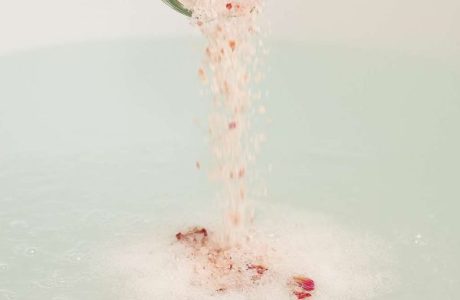
As someone who has suffered from headaches in the past, I know how frustrating and debilitating they can be. Headaches can be caused by a variety of factors, including stress, dehydration, and changes in the weather. They can range from a minor annoyance to a full-blown migraine and can make it difficult to go about your daily routine.
Fortunately, there are many natural remedies that can help alleviate headaches. One of the most effective methods is through the use of DIY bath and body recipes. Not only are these recipes natural and chemical-free, but they can also be tailored to your specific needs and preferences.
One of the latest products is the cold pack gel head packs, at first I was a little skeptical cause traditionally I always add heat to my headaches with a wheat pack, but I wanted to try to cold packs out and the hands-free pack have been quite a game changer for me. I use my MigraFreeze Deluxe Headache cold pack at the start of a headache, I can pop it on and carry on with my work or get kids ready for school etc. (lots of my headaches start when I wake up)
Here are 10 DIY bath and body recipes that can help you find relief from headaches.
Lavender Bath Salts
Lavender has long been used for its relaxing properties and is known for its ability to help alleviate headaches. To make lavender bath salts, you’ll need Epsom salt, baking soda, and lavender essential oil. Epsom salt is known for its ability to soothe sore muscles, while baking soda can help to soften and exfoliate the skin. Lavender essential oil is known for its calming and soothing properties.
To make lavender bath salts, simply mix 2 cups of Epsom salt and 1/2 cup of baking soda in a bowl. Add 10-15 drops of lavender essential oil and mix well. Store the mixture in a jar and add 1/4 to 1/2 cup to your bathwater as needed. The warm water and the scent of the lavender can help to ease tension and promote relaxation.
Peppermint Foot Soak
Peppermint is another essential oil that can help alleviate headaches. It contains menthol, which has a cooling and soothing effect on the skin. To make a peppermint foot soak, you’ll need Epsom salt, baking soda, and peppermint essential oil.
To make the foot soak, mix 1 cup of Epsom salt and 1/4 cup of baking soda in a bowl. Add 10-15 drops of peppermint essential oil and mix well. Fill a basin with warm water and add the mixture. Soak your feet for 15-20 minutes, allowing the peppermint to work its magic.
Ginger Bath
Ginger has anti-inflammatory properties and can help alleviate headaches caused by inflammation. To make a ginger bath, you’ll need fresh ginger root, Epsom salt, and peppermint essential oil.
To make the ginger bath, peel and chop 1/2 cup of fresh ginger root. Simmer the ginger in 4 cups of water for 15-20 minutes. Strain the ginger out of the water and add 1/4 cup of Epsom salt and 10-15 drops of peppermint essential oil. Add the mixture to your bathwater and soak for 15-20 minutes. The warm water and the anti-inflammatory properties of the ginger can help to reduce swelling and ease tension.
Rosemary and Mint Shower Tablets
These shower tablets can be used in the shower to help alleviate headaches. They contain rosemary and peppermint essential oils, which can help to promote relaxation and ease tension. To make the tablets, you’ll need baking soda, water, rosemary essential oil, and peppermint essential oil.
To make the tablets, mix 1 cup of baking soda and 1/3 cup of water in a bowl. Add 10-15 drops of rosemary essential oil and 10-15 drops of peppermint essential oil and mix well. Press the mixture into a silicone mold or ice cube tray and let it dry overnight. To use, place a tablet on the floor of your shower and let the steam release the essential oils.
Aromatherapy Roll-On
This roll-on can be used to apply essential oils directly to your skin, providing fast relief for headaches. To make an aromatherapy roll-on, you’ll need:
10-15 drops lavender essential oil
10-15 drops peppermint essential oil
1/4 cup carrier oil, such as sweet almond oil or coconut oil
Mix the essential oils and carrier oil together in a small bottle or rollerball. Apply the roll-on to your temples, forehead, and neck as needed.
Lavender Eye Pillow
An eye pillow can help alleviate headaches by providing gentle pressure to the eyes and forehead. To make a lavender eye pillow, you’ll need:
1/2 cup flaxseed
10-15 drops lavender essential oil
Fabric (such as cotton or linen) and sewing supplies.
But wait.. what are essential oils?
Essential oils are concentrated plant extracts that have been used for medicinal purposes for centuries. The use of essential oils has gained popularity in recent years, particularly for their ability to aid in the relief of headaches, including migraines. Essential oils are extracted from various parts of plants such as leaves, flowers, roots, and bark. The essential oils that are effective for migraine relief contain compounds that interact with the body’s nervous system, particularly the central nervous system.
Essential oils can be used in a variety of ways, such as inhalation, oral consumption, or topical application. Topical application is particularly effective when it comes to migraines because it allows the essential oils to enter the bloodstream through the skin. When applied topically, the essential oils are absorbed into the bloodstream through the skin’s pores and enter the body, where they can help to alleviate symptoms associated with migraines.
There are several ways to apply essential oils topically to alleviate migraine symptoms. One common method is to use a carrier oil, such as coconut or jojoba oil, to dilute the essential oil and apply it to the skin. Carrier oils help to reduce the potency of the essential oil and prevent skin irritation. Diluting the essential oil also allows it to be spread more easily over a larger surface area of the skin.
Another method of topical application is to use essential oils in a bath. Adding a few drops of essential oils to a warm bath can help to alleviate migraine symptoms. The warm water helps to dilate blood vessels, which can ease tension headaches associated with migraines. The essential oils in the bath water are absorbed into the skin and can help to alleviate migraine symptoms.
Additionally, topical application of essential oils can be achieved through the use of compresses. A compress is a cloth soaked in a mixture of warm water and essential oils that is then applied to the skin. Compresses are particularly effective for headaches that are caused by tension or stress.
When applying essential oils topically for migraines, it is important to apply the oils to the correct area of the body. Essential oils are most effective when applied to the temples, neck, and forehead, which are the areas of the body that are most affected by migraines. When applying essential oils to the skin, it is important to avoid contact with the eyes, mouth, and nose, as these areas can be sensitive to essential oils and can cause irritation.
It is also important to use high-quality essential oils when using them for migraine relief. High-quality essential oils are extracted from organic plants and are free from synthetic additives. These oils are more effective and less likely to cause irritation or adverse reactions.
Affiliate Disclaimer: This blog post contains affiliate links, meaning, if you click through and make a purchase, I may earn a commission. This comes at no additional cost to you and helps support the production of content for this blog. Please note that I only recommend products or services I genuinely believe in and have personally experienced. The decision to purchase through any affiliate links is yours, and your support is greatly appreciated.





Leave a Reply